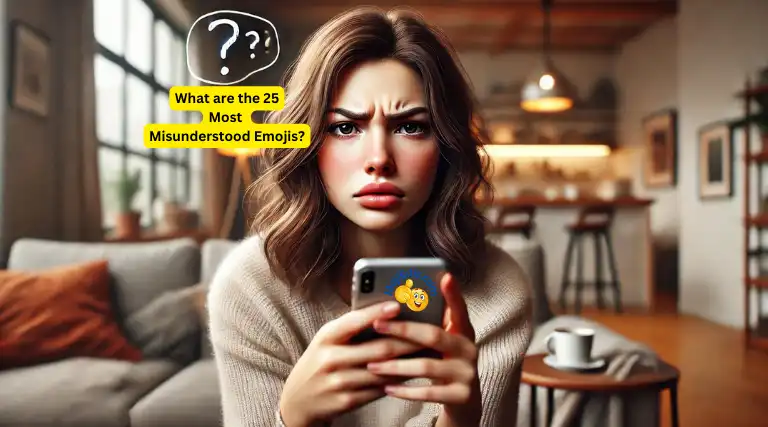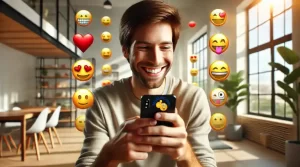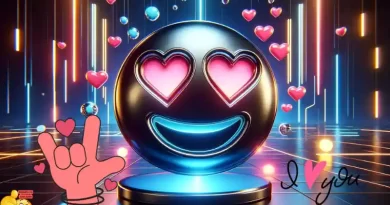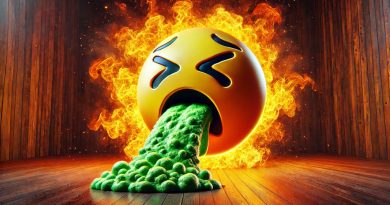25 Most Misunderstood Emojis in 2024: Are You Using Them Correctly?
Let’s talk about the most misunderstood emojis! They’re everywhere, right? Whether you’re texting your best friend, sharing a funny meme, or dropping a quick comment on social media, emojis help add that extra flair to our digital conversations. But here’s the thing—some emojis are tricky! 😬 What you mean to be a light-hearted message might come across totally different to someone else. And that’s where the trouble starts. 😅
In this article, we’re jumping into the top 25 most misunderstood emojis of 2024. We’ll explore why these emojis often get mixed up, share some funny (and maybe awkward) examples, and clear up their actual meanings. By the end, you’ll be an emoji pro, avoiding any potential communication mishaps and sending the right vibes every time. 🎯
Most Misunderstood Emojis
1. Nail Polish Emoji (💅)
- Common Misinterpretations: Often seen as representing “classy,” “bougie,” or self-care rather than simply painting nails.
- Contextual Usage: “Just treated myself to a spa day! 💅 #SelfCare” (used to represent self-care rather than the actual act of painting nails).
- Clarification: This emoji is meant to depict someone painting their nails, often associated with self-care or grooming.
2. Dashing Away Emoji (💨)
- Common Misinterpretations: Misunderstood as representing farting, smoking, or being out of breath instead of motion or speed.
- Contextual Usage: “Got out of there as fast as I could! 💨” (used to show someone leaving quickly, but often misinterpreted as something else).
- Clarification: The emoji is intended to represent quick movement or something moving fast.
3. Upside-Down Smiling Face (🙃)
- Common Misinterpretations: Often interpreted as sarcasm, passive aggression, or smiling through frustration.
- Contextual Usage: “Sure, why not… 🙃” (used to convey sarcasm or irony).
- Clarification: Originally meant to show a playful or ironic smile, not necessarily negative.
4. Person Getting Massage Emoji (💆)
- Common Misinterpretations: Frequently mistaken for someone rubbing their temples out of frustration or exhaustion.
- Contextual Usage: “Ugh, what a day… 💆” (used to show frustration, but it actually represents a massage).
- Clarification: This emoji depicts someone receiving a massage, symbolizing relaxation.
5. Woman Tipping Hand Emoji (💁♀️)
- Common Misinterpretations: Often seen as a sassy gesture or sarcasm rather than offering help.
- Contextual Usage: “Oh, did you not know that? 💁♀️” (used to express sarcasm).
- Clarification: The emoji is meant to represent someone offering help or information.
6. Money with Wings Emoji (💸)
- Common Misinterpretations: The money emoji can be misunderstood as representing gaining money or flaunting wealth, instead of losing money.
- Contextual Usage: “There goes my paycheck… 💸” (used to show money being spent).
- Clarification: This emoji is intended to symbolize money flying away, indicating a loss or expense.
7. Fearful Face Emoji (😨)
- Common Misinterpretations: Often used to show shock, surprise, or sickness rather than fear.
- Contextual Usage: “Did that really just happen? 😨” (used to express shock).
- Clarification: The emoji is meant to represent fear or anxiety.
8. Grimacing Face Emoji (😬)
- Common Misinterpretations: Confused with expressions of awkwardness or embarrassment rather than discomfort or tension.
- Contextual Usage: “I really messed that up… 😬” (used to show awkwardness).
- Clarification: This emoji depicts a face showing discomfort or nervousness.
9. Clapping Hands Emoji (👏)
- Common Misinterpretations: Sometimes perceived as sarcastic applause rather than genuine clapping.
- Contextual Usage: “Well done, I guess… 👏” (used sarcastically).
- Clarification: This emoji is intended to represent applause or congratulations.
10. Praying Hands Emoji (🙏)
- Common Misinterpretations: The praying hands emoji is often mistaken for a high-five rather than prayer, gratitude, or asking for forgiveness.
- Contextual Usage: “Please let this work out… 🙏” (used to represent hope or prayer).
- Clarification: The emoji symbolizes prayer, thankfulness, or asking for forgiveness.
11. Eyes Emoji (👀)
- Common Misinterpretations: The eyes emoji is often seen as suspicious or indicating something secretive rather than just looking or observing.
- Contextual Usage: “What’s going on here? 👀” (used to express curiosity or suspicion).
- Clarification: This emoji is meant to indicate that something is being observed or noticed.
12. Drooling Face Emoji (🤤)
- Common Misinterpretations: Used to show desire or hunger rather than its original meaning of drooling over something, typically food.
- Contextual Usage: “That cake looks so good… 🤤” (used to express hunger or desire).
- Clarification: The emoji is intended to depict drooling, often in relation to food.
13. Relieved Face Emoji (😌)
- Common Misinterpretations: Often used to show satisfaction rather than relief.
- Contextual Usage: “Finally finished that project… 😌” (used to show relief).
- Clarification: This emoji represents feeling relieved after stress or worry.
14. Sleepy Face Emoji (😪)
- Common Misinterpretations: Mistaken for sadness or crying instead of being tired or sleepy.
- Contextual Usage: “I’m so done with today… 😪” (used to express exhaustion).
- Clarification: The emoji is meant to depict sleepiness or fatigue.
15. Smirking Face Emoji (😏)
- Common Misinterpretations: Often interpreted as flirtatious or mischievous rather than just smirking.
- Contextual Usage: “You know what I mean… 😏” (used in a flirty context).
- Clarification: Originally meant to show a smug or sly smile.
16. Thumbs Up Emoji (👍)
- Common Misinterpretations: In some cultures, this is considered offensive rather than a sign of approval or agreement.
- Contextual Usage: “Great job on that report! 👍” (used to show approval).
- Clarification: The emoji is generally intended to express a positive response.
17. OK Hand Emoji (👌)
- Common Misinterpretations: Seen as vulgar in some cultures instead of indicating “OK” or “perfect.”
- Contextual Usage: “Everything’s set for tomorrow! 👌” (used to show approval or agreement).
- Clarification: The emoji is typically meant to indicate something is “OK” or good.
18. Eggplant Emoji (🍆)
- Common Misinterpretations: Our friendly eggplant emoji is frequently used as a phallic symbol rather than just an eggplant.
- Contextual Usage: (Often used in a non-food-related context, which is best left to the imagination).
- Clarification: Originally intended as a vegetable emoji, the eggplant has taken on a different meaning in popular culture.
19. Peach Emoji (🍑)
- Common Misinterpretations: A sexy use of the peach emoji is to symbolize a butt instead of the fruit.
- Contextual Usage: (Similar to the eggplant emoji, often used in a suggestive context).
- Clarification: The emoji represents a peach, though its shape has led to alternative interpretations.
20. Kissy Face Emoji (😘)
- Common Misinterpretations: Sometimes seen as a romantic gesture instead of just a friendly kiss.
- Contextual Usage: “Thanks for helping me out! 😘” (used to express gratitude with affection).
- Clarification: This emoji is often used to signify a friendly kiss or affection, not necessarily romantic.
21. Sparkles Emoji (✨)
- Common Misinterpretations: Used to indicate something magical or whimsical, but it can also imply sarcasm.
- Contextual Usage: “This day has been ✨ magical ✨” (used to show something is special or magical).
- Clarification: The emoji represents something sparkling or shining, often used to highlight something special.
22. Fire Emoji (🔥)
- Common Misinterpretations: Used to indicate something is “cool” or “awesome,” instead of just literal fire.
- Contextual Usage: “That performance was on fire! 🔥” (used to show something is impressive).
- Clarification: While the fire emoji originally represents fire it is commonly used to show that something is “hot” or amazing.
23. Confounded Face Emoji (😖)
- Common Misinterpretations: Seen as expressing extreme frustration or anger instead of distress or being upset.
- Contextual Usage: “Why does this keep happening?! 😖” (used to express frustration).
- Clarification: The emoji depicts someone who is upset or distressed.
24. Zipper-Mouth Face Emoji (🤐)
- Common Misinterpretations: Seen as a secretive or quiet emoji, though it originally means “my lips are sealed.”
- Contextual Usage: “I won’t say a word… 🤐” (used to show secrecy or### 24. Zipper-Mouth Face Emoji (🤐)
- Common Misinterpretations: Seen as a secretive or quiet emoji, though it originally means “my lips are sealed.”
- Contextual Usage: “I won’t say a word… 🤐” (used to show secrecy or discretion).
- Clarification: This emoji is intended to indicate that someone is keeping a secret or not sharing information.
25. Pleading Face Emoji (🥺)
- Common Misinterpretations: Sometimes used to evoke pity or sympathy, instead of its intended expression of pleading.
- Contextual Usage: “Can you please do this for me? 🥺” (used to show pleading or begging).
- Clarification: The pleading face emoji represents someone pleading or asking for something with a hopeful or begging expression.
Cultural Variations in Emoji Meanings
Emojis may seem universal, but their meanings can vary significantly depending on cultural context. What is seen as a harmless gesture or expression in one part of the world might be interpreted very differently in another, leading to potential misunderstandings in cross-cultural communication. Let’s explore a few specific examples of how emoji meanings can differ across cultures:
1. Thumbs Up Emoji (👍)
- Western Cultures: In most Western countries, the thumbs-up emoji is a positive gesture, commonly used to indicate approval, agreement, or that everything is okay.
- Middle East: In certain Middle Eastern countries, this emoji can be highly offensive, akin to giving someone the middle finger in the United States. It’s a gesture that is better avoided in these regions to prevent misunderstandings.
2. OK Hand Emoji (👌)
- United States and Europe: The OK hand emoji generally signifies that everything is “OK” or “perfect.” It’s a gesture of reassurance or agreement.
- Brazil and Southern Europe: In Brazil and parts of Southern Europe, this gesture is considered vulgar or obscene. It can be highly inappropriate in these cultures, so it’s important to use it cautiously.
- Japan: Interestingly, in Japan, the OK hand sign is often used to represent money, as the circular shape is reminiscent of a coin.
3. Folded Hands Emoji (🙏)
- Western Cultures: Often used to express prayer, gratitude, or a simple thank you.
- Japan: In Japan, this emoji is more commonly used to signify a gesture of apology or requesting something. The cultural nuance here reflects a difference in the interpretation of this common symbol.
4. Smiling Face with Smiling Eyes Emoji (😊)
- Western Cultures: This emoji is generally seen as a friendly, warm expression of happiness or contentment.
- China: In China, this emoji might be interpreted as a sign of being uncomfortable or even sarcastic, especially when used in a professional setting.
5. Face with Tears of Joy Emoji (😂)
- Western Cultures: Universally recognized as laughter or something extremely funny.
- China: However, in China, this emoji can sometimes be used to represent fake laughter or to cover up awkwardness, indicating that the person isn’t genuinely amused.
Understanding Cultural Sensitivities
When using emojis in cross-cultural communication, it’s essential to be aware of these differences. A seemingly innocent emoji might convey an unintended message depending on the cultural background of the recipient. To avoid misunderstandings, it’s always a good idea to consider the cultural context of your audience or, when in doubt, to clarify your intent with words alongside emojis.
 Conclusion
Conclusion
And there you have it! 🎉 Emojis are super fun and expressive, but as we’ve seen, they can also be a little confusing. 😵💫 By understanding the true meaning behind these 25 misunderstood emojis, you’ll be able to communicate more clearly and avoid any “Oops, that’s not what I meant!” moments.
Remember, the key to using emojis effectively is knowing your audience and the context. So next time you’re about to hit send, take a quick second to think about how that emoji might be interpreted. It could save you from some awkward explanations later! 😉
Happy texting, and may your emojis always hit the mark! ✌️
Frequently Asked Questions and Answers
The Nail Polish Emoji is frequently misunderstood because people use it to signify “classy” or “self-care,” when in reality, it simply represents the act of painting nails. This emoji’s meaning has evolved over time, leading to different interpretations depending on the context.
The Dashing Away Emoji is intended to depict something moving quickly, like speed or wind. However, it’s often misinterpreted as representing farting, smoking, or even being out of breath, which can lead to some awkward misunderstandings!
This emoji is commonly misused because it’s often taken to convey sarcasm, irony, or passive aggression. Its intended meaning is more playful, representing an upside-down smile meant to lighten the mood or indicate joking around.
The Woman Tipping Hand Emoji is meant to represent offering help or providing information. However, it’s frequently used sarcastically or to imply a sassy attitude, which can confuse the recipient about the sender’s true intentions.
The Money with Wings Emoji originally represents money flying away, symbolizing a loss of money or an expensive purchase. However, many people use it to imply gaining money or flaunting wealth, which is a significant deviation from its intended use.
The Fearful Face Emoji is intended to express fear or anxiety, but it’s often misused to convey shock, surprise, or even sickness. This leads to confusion in digital conversations, especially when the actual context doesn’t match the emoji’s original purpose.
While the Thumbs Up Emoji typically signifies approval or agreement in Western cultures, in certain parts of the Middle East, it’s considered offensive, similar to giving someone the middle finger in the United States. This cultural difference makes it important to use the emoji carefully in cross-cultural communication.
The Sparkles Emoji is intended to represent something sparkling or shining, often used to highlight something special. However, it’s also commonly used to add a whimsical or magical touch to a message, which can sometimes lead to sarcastic interpretations depending on the context.
While the OK Hand Emoji generally means “OK” or “perfect,” it has different meanings in various cultures. In Brazil and parts of Southern Europe, it can be seen as an obscene gesture. It’s essential to be aware of these cultural differences to avoid unintentional offense.
The Peach Emoji is commonly associated with a butt due to its shape, rather than its original meaning as a fruit. This association has become so widespread that it’s often used more in a suggestive context than to represent an actual peach.


 Conclusion
Conclusion


